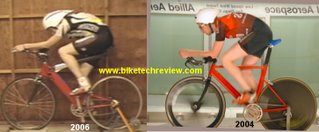Cycling Weekly (cont)
[cycling weekly] Do these principles differ according to the rider's strengths/body shape/riding style/event?
[kraig] The most important principle, IMHO, is understanding that positioning is a process that relies on the experienced use of the best measurement tools. Folks are pretty different in the positions they wind up with, but a good process will guide them along to the best result. If one focuses on the process the results will come.
[cycling weekly] In the case of each of the following, is it possible to say which is best and what sort of rider should use it? (a very stretched out position like the Superman, but within UCI limits. a Tuck position a la Landis and Leipheimer. A wide arms position like the UK Track team.)
[kraig]I don’t think it’s really possible to say which is best without testing it out. I’ve seen the Superman “work”, I’ve seen the Leipheimer position “work”.
[cycling weekly] Why do the UK Track guys ride with their arms so wide, do you think? Similarly what was so good about the Landis/Leipheimer position?
[kraig] I’m not sure why – I know that those guys test at a wind tunnel under the guidance of Chris Boardman (who is fond of telling Anthony McCrossen of cycling.tv that arm position doesn’t matter), so I’m sure they’ve got some evidence that suggests it’s the way to go. Maybe the ex-2006 Tour de France winner (I'm not quite sure how to phrase that - maybe I'll have to consult Floyd's legal team on that one??) just liked the way it felt for his hip – or he simply thought it was “cool” – or he had documented the supply side (power with his power tap) and the demand side (using the data from the tunnel here in san diego), and found that to be the best combination. Levi also uses power and wind tunnel data to guide his positioning decisions – it’s got to work on the road, though!
[cycling weekly] How important is it to get 'narrow' in the hands/elbows/shoulders/knees?
[kraig] People pedal differently, and this can affect the optimal position. I like to do sweeps on elbow width on pedaling riders under load (some facilities can't load up riders with any resistance, which is something to think about) in order to understand how axial force changes – narrower isn’t always better.
[kraig] The most important principle, IMHO, is understanding that positioning is a process that relies on the experienced use of the best measurement tools. Folks are pretty different in the positions they wind up with, but a good process will guide them along to the best result. If one focuses on the process the results will come.
[cycling weekly] In the case of each of the following, is it possible to say which is best and what sort of rider should use it? (a very stretched out position like the Superman, but within UCI limits. a Tuck position a la Landis and Leipheimer. A wide arms position like the UK Track team.)
[kraig]I don’t think it’s really possible to say which is best without testing it out. I’ve seen the Superman “work”, I’ve seen the Leipheimer position “work”.
[cycling weekly] Why do the UK Track guys ride with their arms so wide, do you think? Similarly what was so good about the Landis/Leipheimer position?
[kraig] I’m not sure why – I know that those guys test at a wind tunnel under the guidance of Chris Boardman (who is fond of telling Anthony McCrossen of cycling.tv that arm position doesn’t matter), so I’m sure they’ve got some evidence that suggests it’s the way to go. Maybe the ex-2006 Tour de France winner (I'm not quite sure how to phrase that - maybe I'll have to consult Floyd's legal team on that one??) just liked the way it felt for his hip – or he simply thought it was “cool” – or he had documented the supply side (power with his power tap) and the demand side (using the data from the tunnel here in san diego), and found that to be the best combination. Levi also uses power and wind tunnel data to guide his positioning decisions – it’s got to work on the road, though!
[cycling weekly] How important is it to get 'narrow' in the hands/elbows/shoulders/knees?
[kraig] People pedal differently, and this can affect the optimal position. I like to do sweeps on elbow width on pedaling riders under load (some facilities can't load up riders with any resistance, which is something to think about) in order to understand how axial force changes – narrower isn’t always better.
Labels: cycling weekly, TT Position, Wind Tunnel



